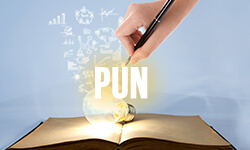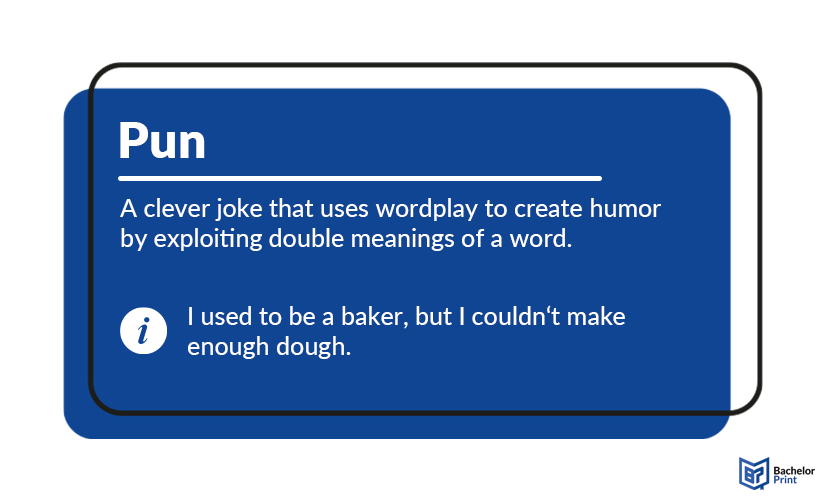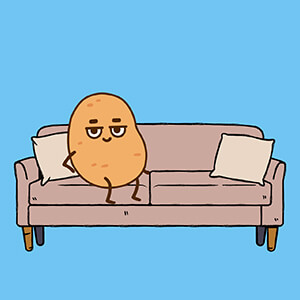
Although puns may seem like a topic that has nothing to do with academic writing, history tells us otherwise. They along with other forms of word play have been an integral part of language and literature since time immemorial, serving as tools for both humour and rhetoric. The craft of punning has been wielded by everyone from Shakespeare to contemporary comedians, revealing its elasticity across genres and its adaptability to different cultures and periods.
Definition: Pun
What is a pun? It is a form of word play that exploits multiple meanings of a term or similar-sounding words for an intended humorous or rhetorical effect. The pun meaning is often centred on a play of words that are either identical in sound (homophonic) or similar enough to create confusion, paired with another word that changes the overall sense. They may rely on lexical, grammatical, or phonological similarities and can function as linguistic devices in written and spoken language.
Fundamentally, this stylistic device adheres to the principle that words are not static symbols, but dynamic entities full of nuances. In addition, they showcase language flexibility, bending conventional definitions to create new understandings or evoke humour. Also, a variety of forms of literature include them, from Shakespearean plays to modern-day advertising, demonstrating their enduring appeal and versatility. In essence, a pun is not merely a joke but a manipulation of language that provokes thought, laughter, or even both.

Types
These forms of word play are a fascinating aspect of language, offering not just humour, but also a glimpse into the complexity and flexibility of words. Their charm lies in their ability to exploit ambiguities in language for effect, whether it is to provoke laughter, thought, or both. Below, we explore the various types that showcase this delightful form of word play.
This type is often used in logos, emblems, and visual media, like cartoons. Here, it’s replaced by the picture. The words might be spelt differently but are phonetically similar, or they could involve visual representations of words that carry multiple meanings.
This type uses words that sound alike but are not synonyms. Those words are also called homophones. They primarily rely on word pairs like “knight” and “night”, or “bear” and “bare”.
A homographic pun uses words that are spelt the same but have different meanings and are usually pronounced differently. These words are also called homographs. “Lead” is a word that can refer to the metal or the verb, to lead someone.
This type involves words that sound and are spelt alike but have different meanings. The humour emerges from the ambiguity of the word in the context of the sentence.
Here, “fun” is a homonym. It can nasty enjoyment or refer to a playful act of trickery.
This type of word play is a complex statement that contains two or more puns.
In the first sentence, “baker” and “dough” exploit their dual meanings related to baking and money.
The second part of a recursive pun relies on the understanding of an element in the first. This creates a loop of understanding.
“Poultry in motion” plays on the phrase “poetry in motion”, but it also refers back to the chicken, making it a recursive pun.
This type repeats a single word or phrase over and over again. However, the meaning changes every time it’s mentioned. The shift in the meaning of a familiar word or phrase is humorous.
In the first sentence, the first “sound” means “solid” or “valid”, while the second “sound” refers to “noise”.
Use
Puns have a rich history that stretches from ancient times to the digital age. Throughout, it served various roles, from rhetorical devices in classical literature to punchlines in modern comedy. The following subsections examine how this play on words has evolved and the many ways in which it is used today.
Usage in history
The usage of puns has a long and storied history, dating back to ancient civilizations. In classical literature, word plays were typically employed for their rhetorical power, serving as tools for persuasion or emphasis. Take, for instance, the plays of William Shakespeare, which are replete with them serving both comedic and dramatic purposes. Shakespearean characters like Mercutio in “Romeo and Juliet” frequently play with his words to lighten the mood, while others use them to convey multiple layers of meaning subtly.
In religious texts like the Bible, playing with words has been used to create memorable sayings or to add poetic flourish. They have also been instrumental in oral storytelling traditions, where the play on words aids in making stories more engaging and easier to remember.
Modern usage
In contemporary times, word plays have found a home in virtually every form of media and communication. Advertising frequently utilizes them to make advertising slogans or jingles more memorable. For example, businesses from cafés to hair salons might use word plays in their names to grab attention.
Stand-up comedians and comedy writers often play with their words as a source of humour in jokes. They usually do quick one-liners or as part of larger comedic narratives. They are staples of children’s literature and shows, where they serve as accessible forms of humour that also encourage language skills like vocabulary development and homophonic recognition.
The digital age has brought forth new platforms for word plays, including social media and memes. Here, word plays regularly become viral phenomena, spreading quickly due to their easily digestible and shareable nature. Hashtags frequently employ them to both entertain and inform, adding a layer of wit to trending topics.
Puns have also been used in more serious contexts, such as in academic essays or political speeches, where they can serve to make the content more engaging or to succinctly underscore a point. However, their usage in such settings is typically more restrained, given the formal tone typically required.
In the media
Puns are used throughout many types of media.
Advertising
- In the realm of advertising, word plays are typically used to create catchy slogans in commercials or product names that are memorable.
Journalism
- It is often employed in a headline to grab the reader’s attention.
- This way, the article becomes more engaging and memorable for the reader.
Social media
- Twitter, Instagram, and TikTok are ideal platforms to use them as a form of expression.
- Trending hashtags typically contain word plays, such as “#Eggcellent” or “#Meowtastic”.
Entertainment media
- Movies or TV shows also use word plays as a comedic element.
- They are incorporated into dialogues to add humour, depth, or a certain dramatic flair.
- A famous show for children that frequently uses them is “SpongeBob SquarePants”.
Music and lyrics
- Here, they are typically used to add layers of meaning to the song.
- They can also serve to highlight clever word play or to create memorable lines.
- Often, rap and hip-hip artists use puns to demonstrate their lyrical skill.
Confusion and alternative uses
One linguistic phenomenon often confused with puns is a malapropism. A malapropism occurs when a wrong similar word is mistakenly used in place of the correct word, usually resulting in a nonsensical, unlogical, or humorous statement.
But why the confusion? Both rely on the use of similar-sounding words, which is why they are sometimes confused. They both regularly result in humour or create a noticeable impact on the audience due to the play on words. However, the key difference lies in the intent and effect.
| Puns | Malapropisms | |
| Intent | Speaker is aware of the multiple meanings or similar sounds of the words being used | Occurs due to confusion or a lack of knowledge regarding the words involved |
| Effect | Lead to humour or more profound meaning due to clever exploitation of linguistic similarities | Result in absurd or nonsensical outcomes that highlight the mistake |
| Audience awareness | Aware that a play on words is happening and that the ambiguity is intentional | Catches the audience off guard and the humour arises from the incorrect usage |
| Context | Frequently used in casual and formal language | Errors, so not found in formal writing |
In addition to malapropisms, people frequently confuse word plays with double entendres. A pun is a form of word play used for comedic or rhetorical purposes, while a double entendre refers to a second meaning that is not explicitly stated in the entire statement, often intended to disguise the second meaning. Puns and double entendres can overlap due to their use of intentional double meaning.
- ✓ 3D live preview of your individual configuration
- ✓ Free express delivery for every single purchase
- ✓ Top-notch bindings with customised embossing

Can you use puns in your bachelor’s thesis?
Using them in a bachelor’s thesis, or any other academic paper, requires careful consideration of several factors. While they can make writing more engaging, there are potential traps to beware of.
Pros:
- Engagement: An aptly placed play on words can make your writing more memorable and enjoyable for the reader.
- Creativity: Demonstrating wit can show that you have a profound understanding of the topic and can approach it from unique angles.
- Attention-grabbing: A clever word play in the title or introduction might intrigue your readers and draw them into your work.
Cons:
- Professionalism: Puns can be perceived as informal in serious academic discourse. Excessive use can lessen the importance of your work.
- Ambiguity: They inherently play with the multiple meanings of words. In an academic setting, where clarity is paramount, this can lead to confusion.
- Cultural differences: They often rely on linguistic nuances that might not be evident to all readers, especially in an international academic setting.
Tips
The question many people are asking themselves is: Can puns coexist with academic seriousness? We provide a few tips for those who dare to tread the fine line between scholarly rigor and linguistic creativity.
- Before finalizing your thesis, get feedback from peers, advisors, or professors to gauge their reactions.
- If there’s any chance your word play could be misunderstood, provide clarification.
- Ensure the play on words is relevant to your topic and adds value, rather than being included just for humour.
While word plays can spice up a bachelor’s thesis, it’s crucial to use them sparingly. The primary focus should always be on coherence, clarity, and conveying your arguments and research effectively. If you decide to use one, ensure it enhances your work rather than detracts from it.
When to use
The usage of puns in academic writing is an ongoing debate among educators, students, and scholars. The formal and scholarly tone as well as the desire to write an engaging paper needs to be balanced out. For this reason, we’ve compiled occurrences when they may be used in academic writing.
- If your thesis is on a lighter topic or examines subjects like linguistics, literature, or humour, plays with words might be more acceptable.
- Will your thesis primarily be read by people who appreciate and understand your sense of humour? Is your audience more conservative or diverse? Depending on the answer, word plays may be welcome or not.
- If you decide to incorporate them, use them sparingly. A word play in the title or the occasional section heading might be acceptable, but littering your work with them can be distracting.
Pun examples
In the following, there will be a plethora of different kinds of pun examples.
Purr-fect cat puns
Cat puns capitalize on the various idiosyncrasies and behaviors of our feline friends to create humour and charm. These word plays resonate with anyone who’s spent time observing the quirks of cats.
Paws-itively hilarious dog puns
Dog puns also have a special place in the world of word play. They exploit the unique characteristics, sounds, and behaviors associated with dogs.
Funny puns
Funny puns are the gems of social gatherings, comedy routines, and even mundane daily interactions. Unlike cat puns or dog puns, which are theme-specific, funny puns can cover a wide range of subjects, from food to occupations and everything in between. Take a look at these punny jokes.
Meaning of “no pun intended”
Often, the phrase “no pun intended” is used immediately after a statement where a word play has occurred. By adding this phrase, the speaker, or writer is acknowledging that they are aware of it. However, they assert that it was not their aim to make a play on words, so there was no word play intended.
Another phrase, “pun intended”, draws attention to a deliberate word play. By saying this, the speaker or writer acknowledges the pun and invites the audience to appreciate the clever use of language, inviting the listeners to appreciate the clever and humorous use of language.
Funny dad jokes
Funny dad jokes are often characterized by their play with words, simplicity, and straightforward delivery. It’s almost impossible not to smile—or groan. These jokes are question-and-answer exchanges or quick one-liners that are easy to remember.
Bad dad jokes
Not all dad jokes are perceived the same. What some might find endearing, others may consider cringe-worthy. Bad dad jokes typically autumn flat due to a predictable punchline or simply because the word play is stretched too thin.
FAQs
Playing with words can take many forms, but it is generally referred to as “word play”. Word play is a literary technique and a form of wit in which the words that are used become the main subject of the work, primarily for intended effect or amusement.
It’s a form of word play that exploits the multiple meanings of a term or the similarities in pronunciation for an intended rhetorical or humorous effect.
Playing with words can manifest in various ways, and one common example is the use of a pun.
- The mathematician’s plants stopped growing, so he found the square root of the problem.
Here, “square root” is a term commonly associated with mathematics, but it’s being used in a different context to refer to the underlying issue and the root of a plant, thus creating a pun.
The term “punning” is a gerund form of the verb “to pun”, which means the act of making a pun. It refers to the process of creating or using word plays in speech or writing. “Punning” isn’t as commonly used as the noun form, but its meaning is clear in the context of discussing word play.
The phrase “to be punning out” isn’t a standard or widely recognised idiom. In the context of word play, it could suggest that someone is continuously making puns or engaging in the act of creating them to an excessive degree. This could be done for comedic effect, to entertain, or even to annoy others, depending on the context and the audience’s receptivity to this form of humour.


